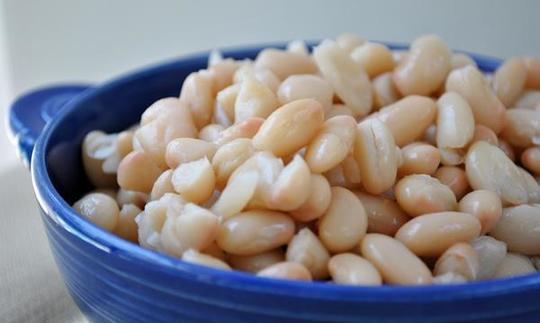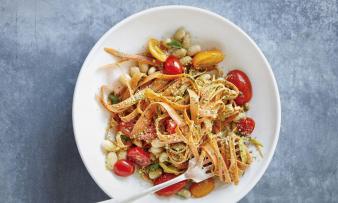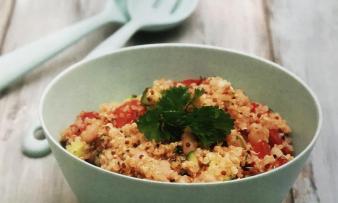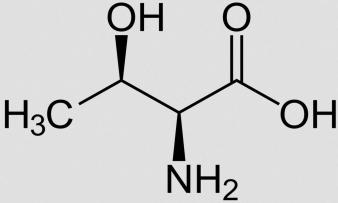Table of contents
White beans are a variety of the common bean ( Phaseolus vulgaris). When cooked, they are a great source of fiber and protein, preferably without salt.
Use in the kitchen
White beans are closely related to kidney beans and also have the typical kidney shape. The skin is white to cream-colored. They are popular in Great Britain and the USA as so-called baked beans. The beans are baked in the oven with a sweet tomato sauce.
As a source of plant-based protein, they are an ideal ingredient in a hearty soup or stew, for example with chard and tomatoes. White beans must always be cooked before eating (see "Your own preparation"). The cooking water from white beans can be used to make aquafaba. If you are making a salad from cooked white beans, you should leave it in the marinade for two to three hours so that the beans can absorb the flavor. A marinade made from white balsamic vinegar, finely chopped walnuts, a little garlic, seasoned withblack pepper and salt has proven to be effective. Black olives, red bell peppers andsweetcorn go well with this.
In the case of store-bought beans, rinse and drain them well before heating to remove any preservatives. Beans from a jar are preferable to those from a can.
Your own preparation
Soak the dried white beans overnight in three times the amount of water, or for 8-12 hours. This reduces the phytic acid in the beans. Phytic acid binds minerals in the human body, so that they are no longer available to the organism. More on this here: " Phytic acid or phytate and soaking or sprouting ".
Pour away the soaking water and rinse the beans well. Put the beans in a pot and fill them with water until they are generously covered. Simmer over medium heat for 45 to 60 minutes until they are as firm as you want. You can cook beans in a pressure cooker without soaking in 30-40 minutes. To make the beans cook faster, you can add a teaspoon of baking soda to the soaking water or cooking water. The baking soda softens the calcareous water and the beans cook faster. You will also sometimes find information that this makes the beans more digestible and causes less flatulence. Acids such as tomato sauce, vinegar and lemon juice should only be added at the very end. Contrary to previous assumptions, salt shortens the cooking time because it softens the cell walls of the beans (and other legumes such as lentils and chickpeas). 3
Vegan recipe for tomato and bean soup
Ingredients (for 4 people): 500 dried white beans, 1 onion, 2 cloves of garlic, 1 tbsp rapeseed oil, 300 g spinach, 3 carrots, 2 celery stalks, 4 beef tomatoes, salt,black pepper, hot paprika powder, 1 bunch of parsley.
Preparation: Cook the beans according to the instructions below (own preparation). Peel and finely chop the onions and garlic. Wash the spinach and let it dry well. Wash the carrots, celery and tomatoes and cut into bite-sized pieces. Put the onions and garlic and rapeseed oil in a large pot. Sauté briefly, then add the chopped vegetables and season with salt, pepper and paprika. Simmer gently for around 20 minutes. Add the cooked beans to the vegetable mixture and simmer for 10 minutes, stirring occasionally, and season if necessary. Just before serving, divide the stew between plates and sprinkle with parsley.
Vegan recipes with cooked white beans can be found under the note: " Recipes that have the most of this ingredient ".
| Not only vegans or vegetarians should read this: Vegans often eat unhealthily. Avoidable nutritional errors. |
Purchasing - Storage
White beans can be bought dried or cooked in jars or cans, sometimes even in organic quality. They are available all year round. You can usually buy them in large supermarket chains such as Coop, Migros, Spar, Rewe, Edeka or Hofer. Other supermarkets such as Aldi, Denner, Volg, Lidl and Billa sometimes have them on offer. White beans are also available in organic supermarkets such as Denn's Biomarkt or Alnatura or in health food stores.
The availability of white beans in the supermarkets mentioned varies depending on the size of the store, catchment area, etc. If you are interested, click on our recorded food prices for the DA-CH countries (above under the ingredient image). There you will find current prices from various supermarkets and their price development.
Storage tips
Cooked white beans can be stored in an airtight container in the refrigerator for one to two days. 10
Ingredients - Nutritional values - Calories
Cooked white beans (organic) contain 118 kcal per 100 g. They are very rich in fiber with 7.0 g/100g. 100 g of beans contain 8.3 g of protein and 21 g of carbohydrates. The fat content is low at 0.45 g/100g. 1
White beans are rich in folate (folic acid) with 102 µg/100g. This corresponds to 51% of the daily requirement. Sprouted lentils (100 µg/100g) and walnuts (98 µg/100g) have similar values. Cooked kidney beans (130 µg),cooked black beans (149 µg) and cooked lentils (181 µg) have a higher folate content. 1
The protein-rich beans contain all eight essential amino acids. Tryptophan and threonine are abundant, with 0.10 g and 0.35 g per 100 g of white beans respectively. Isoleucine, lysine, phenylalanine, leucine, valine and methionine are also present, but in lower amounts. 1
The trace element manganese is contained at 0.52 mg per 100 g. This corresponds to 26.0% of the daily requirement. Cooked chickpeas, for example, have significantly higher values at 0.99 mg/100g, which corresponds to 49% of the daily requirement. 1
The complete ingredients of cooked white beans, the coverage of the daily requirement and comparison values with other ingredients can be found in our nutrient tables. In the article Nutrients explained you will get a detailed insight into the topic.
Health effects
White beans contain plenty of folic acid, which is involved in important metabolic reactions and the development of the central nervous system. Folic acid is particularly important for women who want to have children. 11 For detailed information, see White beans, ripe seeds, raw.
White beans are not only rich in protein, but also in fiber. This is responsible for a healthy digestive system and can have a positive effect on blood sugar levels when consuming carbohydrates and starchy foods, which reduces the risk of type 2 diabetes. 12,13 A diet rich in fiber also leads to a longer feeling of satiety, which can help with weight loss. 14
Dangers - Intolerances - Side effects
White beans, like all varieties of garden beans, are harmful when raw because they contain several substances that are incompatible with humans, including the lectin phasin (phytohemagglutinin), phytic acid and protease inhibitors. These so-called anti-nutrients can be reduced by soaking them in water for several hours and then cooking or sprouting them so that the beans can be eaten. Read more about this in the article on phytic acid.
The polysaccharides (oligosaccharides) contained in white beans are indigestible for humans. However, intestinal bacteria can break down the raffinose and stachyose through bacterial fermentation, producing gas as a byproduct. The development of intestinal gases (flatulence) can vary depending on the bacterial population in the large intestine, which is why beans and pulses are tolerated to varying degrees. People who eat small amounts of fiber usually react more sensitively, and increasing the amount should therefore be done gradually. It has also been shown that not every type of bean has the same reaction, which is why it is worth it for sensitive people to try out different types. 16 To reduce flatulence, it is worth soaking the raw beans overnight before cooking and throwing away the soaking water. There is also some evidence that adding baking soda makes the beans more digestible. 17 Spices such as savory, fennel seeds, anise, coriander seeds, cumin seeds and caraway seeds aid digestion and relax the intestinal muscles, which is why they can reduce flatulence. In the case of gastrointestinal intolerance to oligosaccharides, it is possible to take the enzyme α-galactosidase, which breaks down raffinose into sucrose and galactose, orally. However, this should not be done without medical advice.
Ecological footprint - animal welfare
Pulses such as beans, chickpeas, soybeans, lentils and peas are considered a healthy plant-based source of protein due to their high protein content and fiber. They have a better environmental impact than milk and meat products. Their ecological footprint is smaller because they require less arable land and water and have fewer CO₂ emissions. It is therefore more environmentally and climate-friendly to eat plant-based proteins and corresponding meat substitutes than meat and milk products. In addition, many calories are lost during meat and milk production because more plant-based calories have to be fed to the animals than the animal calories that are ultimately produced. 6,7,8
For more information, see Basic knowledge.
You can buy cooked white beans in shops either in jars or tins. The latter are usually made of aluminum or tinplate. The production of aluminum requires a lot of energy and the raw material bauxite, which has to be mined on large areas (including rainforests). In addition, aluminum production produces an intermediate product that is toxic to the environment, so-called red mud (contains iron and titanium oxides). If disposed of improperly, this causes serious environmental problems. 18 Aluminum can be recycled after use, but this process also requires a lot of energy. 19 However, the same applies to the production and recycling of glass. The weight during transport also has a negative impact. 20 Ideally, you should buy white beans raw and prepare them yourself.
Worldwide occurrence - cultivation
The common bean ( Phaseolus vulgaris) originally comes from Central America and the Andean region of South America. For a long time it was assumed that there were two centers of domestication, but more recent studies show that the common bean was probably first domesticated in Mexico and only later cultivated in the Andean regions. 4 In the 16th century, common beans were introduced to Europe, with varieties from Central and South America being cultivated. Over the centuries, Europe developed its own varieties through hybridization. 5
In international trade, no distinction is made between the individual varieties of garden beans. According to FAOSTAT, 27.4 million tons of dried beans were produced worldwide in 2020. 2
For information on cultivation and harvesting, see the article White beans, mature seeds, raw.
Industrial production
Cooked white beans can be bought in cans or jars. Italy is the world's largest producer and supplier of canned beans. 9
The beans come to the processing plants, usually as dry products. First they are soaked in water overnight. Then they are briefly blanched at 80 to 85 °C. After filling them into the cans, they are filled with infusion liquid. This often contains salt and spices, sometimes also modified starch. The latter prevents the white beans from bursting during sterilization. After the cans are hermetically sealed, they are heated in special pressure vessels at overpressure to 115 to 140 °C. They are then quickly cooled to 20 °C so that the beans do not overcook and become mushy. 15
Further information
White beans are a variant of the common bean ( Phaseolus vulgaris). This belongs to the subfamily Faboideae. The pods of the common bean ( Phaseolus vulgaris) can be flat or round in cross-section, and can be marbled in different colors such as green, yellow, purple or black. The seeds of the common bean also have different colors and shapes.
Alternative names
There are various 'white beans', the best known varieties are Cannellini, Soisson, Alubia and Gigantes. In English-speaking countries they are known as white beans.
The term 'white bean' is sometimes used for broad beans ( field beans). However, this is not another variety of garden bean, but belongs to the vetch family.
Bibliography - 20 Sources
| 1. | USDA United States Department of Agriculture. |
| 2. | FAOSTAT Food and Agriculture Organization of the United Nations. Beans, dry (2020). |
| 3. | Bundeszentrum für Ernährung. Häufige Fragen zu Hülsenfrüchten. |
| 4. | Bitocchi E, Nanni L, Bellucci E, Rossi M, Giardini A, Zeuli PS, Logozzo G, Stougaard J, McClean P, Attene G, Papa R. Mesoamerican origin of the common bean (Phaseolus vulgaris L.) is revealed by sequence data. Proc Natl Acad Sci U S A. 2012 Apr 3;109(14): E788-96. |
| 5. | Angioi SA, Rau D, Attene G, Nanni L, Bellucci E, Logozzo G, Negri V, Spagnoletti Zeuli PL, Papa R. Beans in Europe: origin and structure of the European landraces of Phaseolus vulgaris L. Theor Appl Genet. 2010 Sep;121(5): 829-43. |
| 6. | Institut für Energie- und Umweltforschung Heidelberg. Ökologische Fussabdrücke von Lebensmitteln und Gerichten in Deutschland (PDF). |
| 7. | WWF. Die Proteinfrage. Von pflanzlichen Alternativen bis hin zu Insekten (PDF). |
| 8. | Albert-Schweitzer Stiftung. Das steckt hinter einem Kilogramm Rindfleisch. |
| 9. | Centre for the Promotion of Imports (CBI). Netherlands Ministry of Foreign Affairs. The European market potential for common dry beans. 2022. |
| 10. | Bundeszentrum für Ernährung. Lebensmittellagerung im Haushalt (PDF). |
| 11. | Biesalski H K, Grimm P. Taschenatlas der Ernährung. Stuttgart: Georg Thieme Verlag; 2015, 6. Auflage. |
| 12. | Gill SK, Rossi M, Bajka B, Whelan K. Dietary fibre in gastrointestinal health and disease. Nat Rev Gastroenterol Hepatol. 2021 Feb;18(2): 101-116. |
| 13. | Evans CEL. Dietary fibre and cardiovascular health: a review of current evidence and policy. Proc Nutr Soc. Februar 2020;79(1): 61–7. |
| 14. | Miketinas DC, Bray GA, Beyl RA, Ryan DH, Sacks FM, Champagne CM. Fiber intake predicts weight loss and dietary adherence in adults consuming calorie-restricted diets: the pounds lost (Preventing overweight using novel dietary strategies) study. J Nutr. 1. Oktober 2019;149(10): 1742–8. |
| 15. | Bundeszentrum für Ernährung. Hülsenfrüchte: Verarbeitung. |
| 16. | Winham DM, Hutchins AM. Perceptions of flatulence from bean consumption among adults in 3 feeding studies. Nutr J. 2011 Nov 21;10: 128. |
| 17. | Queiroz K da S, Oliveira AC de, Helbig E et al. Soaking the Common Bean in a Domestic Preparation Reduced the Contents of Raffinose-Type Oligosaccharides but Did Not Interfere with Nutritive Value. Journal of Nutritional Science and Vitaminology. 2002;48(4): 283–289. |
| 18. | Brough D, Jouhara H. The aluminium industry: A review on state-of-the-art technologies, environmental impacts and possibilites for waste heat recovery. International Journal of Thermofluids. 2020; Vol 1-2. |
| 19. | Paqualino J, Meneses M, Castells F. The carbon footprint and energy consumption of beverage packaging selection and disposal. Journal of Food Engineering. 2011; 357-365. |
| 20. | Ghenai C. Life Cycle Assessment of Packaging Materials for Milk and Dairy products. Int. J. of Thermal & Environmental Engineering Volume 4.2012; 117-128. |











Comments